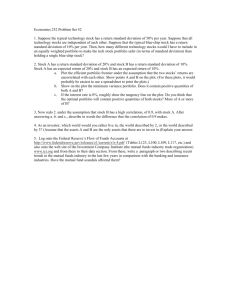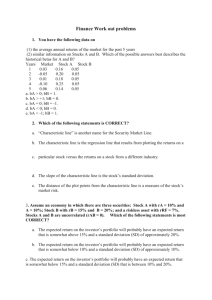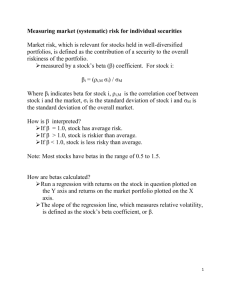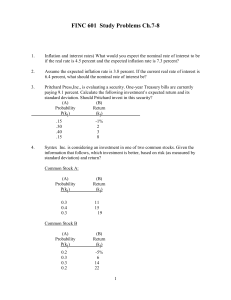Risk and Rate of Return
advertisement
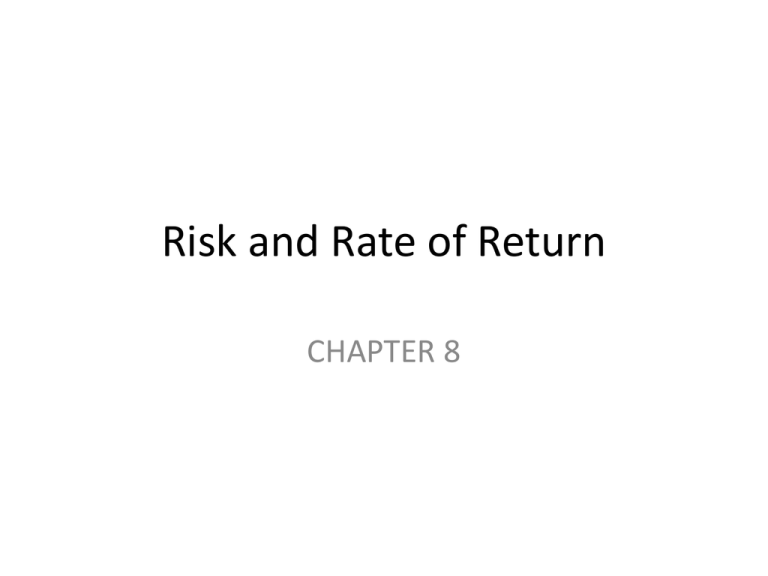
Risk and Rate of Return CHAPTER 8 Introduction 1. Central Ideal 2. While doing ‘risk analysis’ it can help if we keep in mind the following points: 1. Business Assets and Cash Flows 2. Classification of Assets 3. Measurement of stock risk • • Difference between stand-alone and portfolio risk Importance of stand-alone risk analysis 4. Stock’s risk in a portfolio context 5. Investor’s aversion to risk Return • Whenever an individual makes an investment he does so with the expectation of earning more money in the future. • Return can be defined as ‘something over and above my basic investment’. • Return can be expressed both in dollar terms and percentage return terms. Return in dollar terms • Definition • Calculation • Two main problems arise when expressing returns in dollar/rupee terms: – Size/scale of investment – Timing of return Return in percentage terms • The scale of investment and timing of return problem associated with expressing returns in $ form can be resolved if we express investment result in rate of return or percentage return form. • Calculation – ROR solves the problem of knowing scale of investment for forming a meaningful judgment about value of return. – ROR solves timing of return problem as returns normally are expressed on an annual basis. Risk • Definition of Risk • Risk is defined as: – A hazard, exposure to loss or injury. – Chance of occurrence of an unfavorable event. – Risk is the dispersion of returns around mean, or expected mean. • In this chapter our focus will be to carry out risk analysis for stocks. Investment in stocks and the associated riskiness • • • • Goal behind investment of funds Low risk securities offer low return Stocks offer higher returns, but are more risky It is important to remember that, “No investment should be undertaken unless the expected rate of return is high enough to compensate for the perceived risk.” • Investment in risky assets – Investment in risky assets generally results in returns that is less or more than what was originally expected of them, rarely if ever do they produce their expected returns. • Investment risk – Investment risk, then, is related to the probability of earning a low or negative actual return on an investment. The greater the chance of earning lower than expected or negative returns, the riskier the investment. Methods for analyzing riskiness of an asset • As discussed before an asset’s risk can be analyzed in two ways: – Stand-alone basis: On a stand alone basis the riskiness of the asset is considered all by itself. – Portfolio basis: When analyzing the riskiness of a stock in a portfolio, the riskiness of the stock is considered in relation to other stocks held in the portfolio. • We’ll first analyze how to measure a stock’s risk on a stand-alone basis. 1. Stand-alone Risk and Return 1. Calculation of stand-alone risk – Standard deviation 1. For standard deviation calculation we need to know expected rate of return 2. Calculation of stand-alone risk involves discussion on following important concepts: • • • • Probability distribution Expected Return Standard deviation Coefficient of Variation (CV) i. Probability Distribution • Definition for an event’s probability • Example • Definition of probability distribution i. Probability Distribution (contd.) • After discussion on probability and describing what exactly probability distribution is we will concentrate our attention on determining how to measure: – Expected return on individual stock – Standard deviation or risk on an individual stock Calculation of Expected Return (Example # 1) • Example – Two companies, Martin Company and US Water Company. – Martin Company: In an industry where there is intense competition. • Arrival of a better rival can wipe out MC from industry. • Cash flows of MC are not known with certainty. • Risky stock means future earnings are not known with certainty. Calculation of Expected Return • We will now set up probability distribution for MC where outcomes are represented by state of the economy. • Probabilities are set by experts according to expected economic conditions. Economy Probability of this reflecting demand demand occurring of the product ROR if this demand occurs Strong 0.30 80% Normal 0.40 10% Weak 0.30 -60% Product (2*3) Calculation of Expected Return Formula for calculating rate of return on Martin Company’s stock rm expected rate of return on Martin Company' s stock ^ N r ri Pi i 1 Calculation of Expected Return • After determining expected return on Martin company’s stock we now turn our attention to US water company. • US water company operates in a stable industry as it is supplying an essential service so its sale and profits are relatively more stable and predictable. – Even if the economy fluctuates people will not stop drinking water. – It means USWC has stable future earnings which can be predicted with much more accuracy hence it is a less risky stock. Calculation of Expected Return • US Water Company Economy Probability of this reflecting demand demand occurring of the product ROR if this demand occurs Strong 0.30 15% Normal 0.40 10% Weak 0.30 5% Product (2*3) • Note that USWC’s ROR vary much less than Martin Company’s because its future earnings can be predicted with much more certainty. Graphing the ROR of Martin Co. and USWC • Done to obtain a picture of the variability of possible ROR of each. • The height of the bar signifies the probability that an outcome will occur. Summary Expected Rate of Return for MC and USWC Stock Expected return MC 10% USWC 10% • Both the investments give equal expected return. • Looking at this data only, investment can be made in either of the two stocks as they give equal rate of return. • Have we failed to take account of risk? Yes. • Let’s now calculate take into account riskiness of these stocks. Stand-alone risk • Risk is the dispersion of returns around mean. • Standard deviation (si) measures stand-alone risk. • The larger the si , the lower the probability that actual returns will be close to the expected return. Calculation of Risk for Individual Stock through Standard Deviation Calculation s Standard deviation s Variance s 2 σ N (r r) i 1 i 2 Pi Summary Standard deviation for MC and USWC Stock Standard Deviation MC 54.22% USWC 3.873% • Standard deviation (si) measures stand-alone, risk. • The larger the si , the lower the probability that actual returns will be close to the expected return. • From the data above, MC has a higher standard deviation than USWC which means MC’s stock is riskier than USWC’s and is not as safe a investment as MC. Decision Time Stand-alone risk and return for HT and USR stocks Martin Company • r= 10% • s= 54.22% USWC Co. • r = 10% • s= 3.873% 22 Decision Time: Coefficient of Variation • The Coefficient of Variation (CV) measures risk per unit of expected return. • CV is a standardized measure of dispersion about the expected return. • In simple words, CV tells how risky a stock is in relation to its expected rate of return. • The higher the expected rate of return as compared to standard deviation of a stock, lower is the riskiness of the stock and vice versa. • Formula 23 Decision Time: Coefficient of Variation CV (MC) σ/r 54.22/10 5.42 CV (USWC) σ/r 3.873/10 0.39 Decision: Investment in USWC stock is a safer option as its risk per unit of return is relatively less than that of USR stock. 24 Calculation of Expected Return (Example # 1) In order to see how a stock’s stand-alone risk and return are calculated let’s proceed with an example where we calculate stand-alone return and risk of two stocks, HT and USR. Probability Distributions and Expected Returns Economy Pi HT USR Recession 0.1 -60% -8% Below avg 0.2 -20% -2% Average 0.4 30% 5% Above avg 0.2 60% 12% Boom 0.1 90% 20% Expected Rate of Return for HT Stock ^ k HT expected rate of return on HT stock ^ N k ri Pi i 1 ^ k HT (-60%) (0.1) (-20%) (0.2) (30%) (0.4) (60%) (0.2) (90%) (0.1) ^ k HT 23% Expected Rate of Return for USR Stock ^ k USR expected rate of return on USR stock ^ N k ri Pi i 1 ^ k USR (-8%) (0.1) (-2%) (0.2) (5%) (0.4) (12%) (0.2) (20%) (0.1) ^ k USR 5.20% Summary Expected Rate of Return for HT and USR Stock Expected return HT 23% USR 5.20% • HT has the highest expected return, and appears to be the better investment alternative than USR, but is it really? • Looking at this data only investment should be made in USR’s stock only. • Have we failed to take account of risk? Yes. • Let’s now calculate take into account riskiness of these stocks. Calculating Standard Deviation s Standard deviation s Variance s 2 σ N (K i 1 k̂ ) Pi 2 i Probability Distributions and Expected Returns Economy Pi HT USR Recession 0.1 -60% -8% Below avg 0.2 -20% -2% Average 0.4 30% 5% Above avg 0.2 60% 12% Boom 0.1 90% 20% Standard Deviation for HT s N i 1 (K i K̂) 2 Pi (-60 - 23) (0.1) (-20 - 23) (0.2) (30 - 23) 2 (0.4) (60 - 23) 2 (0.2) (90 - 23) 2 (0.1) 2 s HT s HT 42% 2 1 2 Standard Deviation for USR s N i 1 (K i K)2 Pi (-8 - 5.20) (0.1) (-2 - 5.20) (0.2) sUSR (5 - 5.20) 2 (0.4) (12 - 5.20) 2 (0.2) (20 - 5.20) 2 (0.1) 2 sUSR 10.49% 2 1 2 Summary Expected Rate of Return for HT and USR Stock Standard Deviation HT 42% USR 10.49% • Standard deviation (si) measures stand-alone, risk. • The larger the si , the lower the probability that actual returns will be close to the expected return. • From the data above, HT has a higher standard deviation than USR which means HT’s stock is riskier than HT’s and is not as safe a investment as HT. • Looking at this data only investment should be made in USR’s stock only. • On the other hand, if investment was made looking solely at expected return, HT was a better choice as it returned 23% against USR’s 5.20%. Decision Time: Coefficient of Variation CV (HT) σ/k 42/23 1.83 CV (USR) σ/k 10.49/5.20 2.00 Decision: Investment in HT stock is a safer option as its risk per unit of return is relatively less than that of USR stock. 35 Stand-alone risk and return for HT and USR stocks HT Company • K= 23% • s= 42% • CV = 1.83 USR Co. • K = 5.20% • s= 10.49% • CV = 2.00 36 Risk Aversion and Required Return • Investors, generally, are risk averse and require high rate of return in order to induce them to take the risk of putting their money in a high risk investment. 2. Portfolio Risk and Return • Discussion will focus on: 1. Portfolio Returns and Portfolio Risk – Calculate the expected rate of return and volatility for a portfolio of investments and describe how diversification affects the returns of a portfolio of investments. 2. Types of Risk – A stock’s risk consists of diversifiable and market risk. The only relevant risk that a stock in a portfolio faces is its market risk. Beta coefficient is a measure of stock’s market risk and it is measured by the extent to which the return on a stock moves with the overall stock market. 3. The CAPM and the SML Equation – Estimate an investor’s required rate of return. 38 Portfolio Return Assume a three-stock portfolio, total investment capital of $150,000 with $50,000 investment in each of the three stocks A, B and C. ^ Calculate kp and sp. ^ Portfolio Return, rp ^ rp is a weighted average of the expected return of each asset in the portfolio : n rp = S wiri ^ i=1 ^ Types of Risk A stock’s risk consists of diversifiable and market risk. 1. Diversifiable risk • Firm-specific, industry specific risk is that part of a security’s stand-alone risk that can be eliminated by proper diversification. 2. Market risk. • Non-diversifiable, relevant risk is that part of a security’s stand-alone risk that cannot be eliminated by diversification, and is measured by beta. Types of Risk (contd.) • The more an investor diversify into different companies located across different industries the less risky his portfolio becomes. • If a stock is held in a reasonably well-diversified portfolio that is containing 40 or more stocks, almost 50% of its risk can be reduced. • Total risk = Diversifiable risk + Market risk • As number of stocks increases, total risk decreases as diversifiable risk decreases. i. Diversifiable Risk • Industry specific factors • Company specific factors ii. Non-diversifiable, Market Risk • Refers to the type of risk that cannot be eliminated through diversification. • For example factors such as war, inflation, recession etc. effects all the companies and industries in an economy. • All stocks will bear the negative effect of these factors and will decrease in value. • For example, after the 9/11 incident all stocks decreased in value. • Market risk is beyond control of investors. • Aim of making portfolio is to reduce diversifiable risk, remaining risk is called market risk. 44 Figure: Diversifiable and Market Risk Riskiness of Assets held in portfolios (Effect of diversification) • Asset held as part of portfolio is much less riskier than an asset held alone. • Investors like to hold their stocks in form of portfolios. (Why?) • Example to explain the importance of holding assets in the form of portfolios. • The process of reducing risk by investing across different sectors/industries is called ‘diversification’. • As investors hold portfolio of stocks, the risk and return of a security should be analyzed in terms of how that stock affects the portfolio in which it is held. 46 Effect of Portfolio Size on Portfolio Risk for Average Stocks • As more stocks are added, each new stock has a smaller risk-reducing impact. • sp falls very slowly after about 10 stocks are included, and after 40 stocks, there is little, if any, effect. Figure: Effect of Portfolio Size on Portfolio Risk for Average Stocks Beta Coefficient For measuring relevant risk of a stock • As more and more assets are added to a portfolio, portfolio risk reduces. • However, we could put every conceivable asset in the world into our portfolio and still have risk remaining. • This remaining risk is called Market Risk and is measured by Beta. • When we hold a stock in the portfolio we reduce its diversifiable risk, the only risk remaining is ‘market risk’. • Beta is a measure stock’s market risk and is measured by the extent to which return on a stock moves with the overall stock market. 49 Beta Coefficient For measuring relevant risk of a stock • For a stock having a beta of 1 it means it is as risky as market. If market moves up by 10% stock also moves up by 10% similarly if market moves down by 10% stock also moves down by 10%. • For a stock having a beta of 2 it means it is more volatile than the market. If market moves up by 10% stock moves up by 20% similarly if market moves down by 10% stock moves down by 20%. • For a stock having a beta of 0.5 it means it is only half as volatile as the market. If market moves up by 10% stock moves up by 5% similarly if market moves down by 10% stock moves down by 5%. Beta Coefficient For measuring relevant risk of a stock • • • • If beta = 1.0, average stock. If beta > 1.0, stock riskier than average. If beta < 1.0, stock less risky than average. Most stocks have betas in the range of 0.5 to 1.5. Use of Beta Coefficient to measure Return on a Stock • After calculating the riskiness of a stock using the beta coefficient, we now measure the ROR on a stock using the SML equation. Use of Beta Coefficient to measure Return on a Stock • Suppose there are two companies, AA and BB. The beta coefficient for company AA is 0.85 and the beta coefficient for company BB is 1.50. • Keeping this data in mind we can calculate the required returns on the stocks of AA and BB with the help of SML equation. Security Beta AA 0.85 BB 1.50 SML Equation • RPM = market risk premium = rM - rRF • RPi = stock risk premium = (RPM)bi • ri = rRF + (rM - rRF )bi ri = rRF + (RPM)bi 56 Using the SML to calculate the required returns SML: ri = rRF + (rM – rRF)bi . • • • • Assume : rRF = 8%. rM = 15%. RPM = rM – rRF = 15% – 8% = 7%. Using the SML to calculate the required return on stock of AA and BB companies. SML: ri = rRF + (rM – rRF)bi . • ri = rRF + (rM – rRF)bi • rAA = 8% + (7 * 0.85) • rAA = 13.95% • ri = rRF + (rM – rRF)bi • rBB = 8% + (7 * 1.50) • rBB= 18.5% SML: ri = 8% + (15% – 8%) bi ri (%) SML . BB rM = 15 rRF = 8 -1 0 . . . T-bills 1 AA 2 Risk, bi CAPM Example • What is Intel’s required return if its B = 1.2 (from ValueLine Investment Survey), the current 3-month T-bill rate is 5%, and the historical US market risk premium of 8.6% is expected? • Solve 60 We now calculate beta for a portfolio with 50% investment in AA stock and 50% in BB stock bp= Weighted average = 0.5(bAA) + 0.5(bBB) = 0.5(0.85) + 0.5(1.50) = 1.175 Changes to SML Equation • What happens if inflation increases? • What happens if investors become more risk averse about the stock market? • What happens if beta increases? 62 i. Impact of increase in inflation • If investors raise inflation expectations by 3%, what would happen to the SML? • The risk-free rate as measured by the rate on U.S. Treasury securities is called the nominal, or quoted, rate; and it consists of two elements: rRF = r* + IP. • Therefore, the 6% rRF mentioned in the previous equation (ri = 6% + (5%) bi ) might be thought of as consisting of a 3% real risk-free rate of return plus a 3% inflation premium: rRF = r* + IP = 3% + 3% • However, now assume that expected inflation rate rose by 2% i.e. IP = 3% + 2% = 5% • Because of increase in inflation premium, risk free rate increases to 8%. rRF = k* + IP = 3% + 5% = 8% Impact of increase in inflation • In simple words, – As inflation increases, kRF increases. • ki = kRF + (kM – kRF)bi kRF = k* + IP Under CAPM an increase in kRF leads to an equal increase in ROR of all risky assets. ii. Impact of increase in investor’s risk aversion • The slope of the SML reflects the extent to which investors are averse to risk—the steeper the slope of the line, the more the average investor requires as compensation for bearing risk. iii. Impact of increase in beta • An increase in beta means an increase in market riskiness of the stock which leads to increased required rate of return on stocks.

